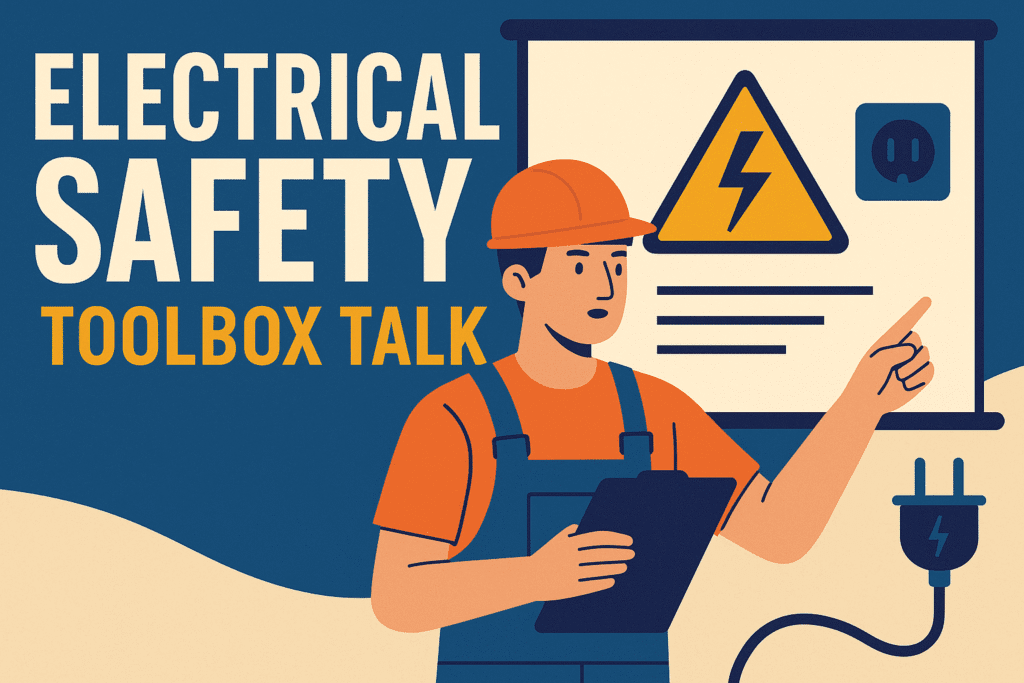
Electrical Safety Toolbox Talk – Preventing Shocks, Fires, and Accidents
Good morning, team!
Today, we’re focusing on a topic that can be as invisible as it is deadly — electricity. Whether you work in construction, manufacturing, maintenance, or an office setting, electrical hazards are present almost everywhere.
Electricity is essential for powering our tools, lighting our workspace, and running our equipment — but when handled incorrectly, it can cause severe injuries, fires, or even fatalities.
Let’s break down the risks, safe practices, and emergency steps so we all go home safe.
1. Why Electrical Safety Matters
- Electricity is silent and invisible — you can’t smell, hear, or see it until it’s too late.
- OSHA reports that electrical hazards cause over 300 deaths and thousands of injuries annually in the U.S.
- Most accidents occur due to unsafe equipment, poor work practices, or lack of PPE.
2. Common Electrical Hazards in the Workplace
Here are the most frequent hazards you may encounter:
- Exposed live wires – risk of shock or electrocution.
- Damaged insulation – frayed cords can cause arcing or fires.
- Overloaded circuits – can cause overheating and equipment failure.
- Wet conditions – water is a strong conductor of electricity.
- Improper grounding – increases shock risk.
- Unauthorized repairs – work done by untrained personnel.
💡 Example: A worker using a drill with a frayed cord in a damp environment is at high risk of both shock and fire.
3. Key Safety Rules for Electrical Work
To stay safe around electricity:
- Assume all wires are live until verified safe.
- Use insulated tools and rubber-soled shoes.
- Inspect cords and plugs daily before use.
- Never bypass protective devices like circuit breakers.
- Do not use electrical equipment with wet hands or near water.
- Report faulty equipment immediately.
4. PPE for Electrical Safety
Personal Protective Equipment (PPE) reduces risk but doesn’t replace safe practices.
| PPE Item | Purpose |
|---|---|
| Insulated gloves | Prevents electric shock through hands |
| Arc-rated clothing | Protects against arc flash burns |
| Safety goggles | Protects eyes from sparks and flying debris |
| Rubber mats | Insulates worker from ground contact |
5. Lockout/Tagout (LOTO) for Electrical Safety
Lockout/Tagout (LOTO) ensures machines are properly shut off and cannot be restarted while maintenance is being performed.
Steps:
- Identify all energy sources.
- Switch off the machine/equipment.
- Apply a lock and tag to the switch/breaker.
- Test to confirm zero energy before starting work.
6. Safe Use of Extension Cords
- Use only industrial-grade cords with proper grounding.
- Avoid running cords through doorways or walkways.
- Do not daisy chain multiple extension cords.
- Store cords properly to prevent damage.
7. Electrical Safety in Wet Environments
- Use Ground Fault Circuit Interrupters (GFCIs).
- Keep electrical equipment elevated from water-prone areas.
- Dry hands before touching switches or plugs.
8. Emergency Response for Electrical Incidents
If someone is electrocuted:
- Do not touch them directly while they are still in contact with the power source.
- Turn off the power supply.
- Call emergency services immediately.
- Start CPR if trained and the victim is unresponsive.
In case of an electrical fire:
- Use a Class C fire extinguisher (never water).
- Shut down power before attempting to put out the fire.
9. Electrical Safety Inspection Checklist
Here’s a quick workplace checklist you can follow:
| Item | Check | Yes/No |
|---|---|---|
| Cords and plugs in good condition | No frays, cuts, or exposed wires | |
| Circuit breakers labeled | Correct and visible labeling | |
| GFCIs in wet areas | Installed and functional | |
| Equipment grounded | Verified with testing | |
| PPE available and used | Gloves, goggles, arc-rated clothing |
10. Real-Life Case Study
Incident: An electrician suffered burns when working on a live panel that was not de-energized.
Cause: Failure to lockout and verify power isolation.
Lesson: Always follow LOTO and test before touching.
11. Conclusion
Electrical hazards may be silent, but their consequences are loud and devastating.
By following safe practices, using PPE, and adhering to LOTO procedures, we can prevent accidents and keep our workplace safe.
✅ Internal Link: Fire Safety Toolbox Talk – Prevention, Response, and Evacuation
Heat Stress Prevention Toolbox Talk
Emergency Evacuation Procedures – Step-by-Step Workplace Guide
Lockout and Tagout – LOTO Safety Procedure
How to Perform a Fire Risk Assessment in the Workplace – Step-by-Step Guide
✅ External Link: OSHA Electrical Safety Standards






















